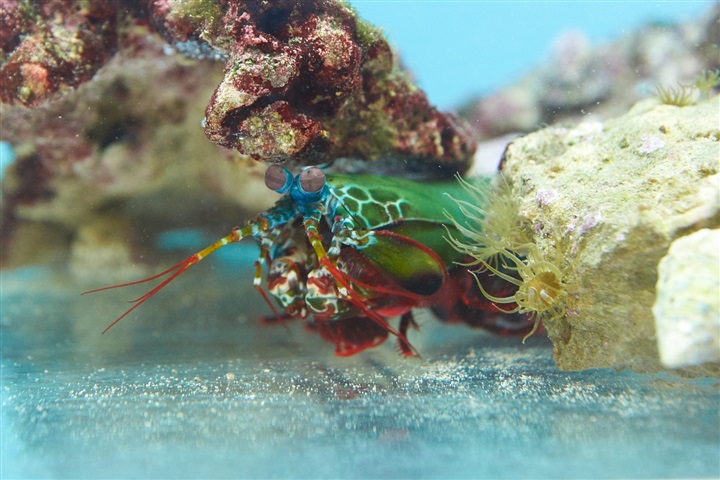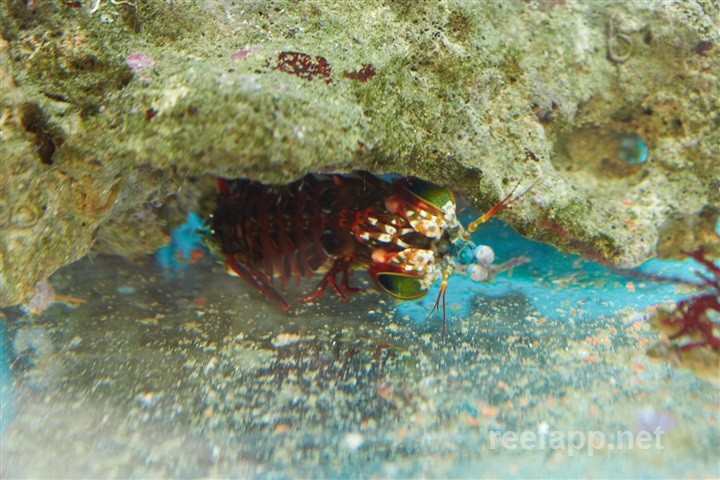Odontodactylus scyllarus



| Latin name | Odontodactylus scyllarus |
|---|---|
| Local name | Peacock mantis shrimp |
| Family | Stomatopoda - Odontodactylus |
| Origin | East Indian Ocean, West Indian Ocean, Australia, Indonesia, Central/West Pacific |
| Max length | 18 cm (7.1") |
| Minimum volume |
100 l (26 gal) |
|---|---|
| Hardiness |
Average |
| Suitable for aquarium |
Suitable for special aquariums |
| Reef safe |
Reef safe with caution |
| Aggressiveness | Might be aggressive towards similar species |
| Recommended |
Fish Larger crustaceans (Shrimp, crabs...) Other invertebrates |
|---|
This species thrives best in an aquarium with dimmed lighting.
This species will eat shrimps, crabs, small bivalves, snails and the like.
This species can pose a threat towards fish that are relatively large in comparison to its own size.
This species often becomes malnourished in captivity, it is therefore important to enrich their food with omega-3 and vitamins.
This Mantis Shrimp is a "smasher", see the below description.
This species needs good hiding places, for example, between live rocks.
Mantis shrimp (Stomatopoda) have an interesting way of hunting their prey whilst also sometimes being very pretty, making them a very interesting animal.
There are two types of Mantis shrimp:
"Smashers":
Will crush even the hardest of shells of various invertebrates, but will also occasionally go for fish.
To give them the opportunity to break some shells, try feeding them raw crustacean which have a hard shell.
They may hit the aquarium's glass as a way of extending their cave. By placing plexiglass on the bottom of the tank, and ensuring their cave is not placed next to the sides, one can eliminate this problem.
Smashers live in caves between the rocks, but they may also dig into the sand.
"Spearers":
Have very long barbed arms, which they use to catch softer prey, like fish for example.
As they live on the bottom of the tank, the substrate must be deep enough to accommodate the Mantis' size.
What they both have in common is that unless one buys a very small species, they will often require a dedicated aquarium. When attempting to keep them with other fish one should know that the larger species will eat most of the other animals in the tank.
Mantis shrimps should be fed every couple of days, and will only eat when hungry.
Their food should be varied and enriched with omega-3 and vitamins. They are not usually choosy about their food, and can be fed all types of raw seafood.
After changing their shell, they will often hide and refuse to eat for about a week.
Read more about the many different species here.
Odontodactylus scyllarus - Wikipedia - (English)
Roy Caldwell. Introduction to Stomatopoda - (English)
2013. Tanks for a peacock mantis shrimp - The Reef Tank - (English)
James W. Fatherree. 2013. Aquarium Invertebrates: An Introduction to the Mantis Shrimps - Advanced Aquarist - (English)
James Fartherree. 2004. A load of learnin' about the mantis shrimp - Reefkeeping Magazine - (English)
Bob Fenner. Mantis Shrimps, Smashers and Thumb-Splitters, Order Stomatopoda - Wet Web Media - (English)

